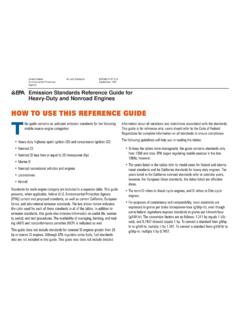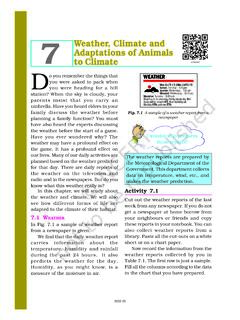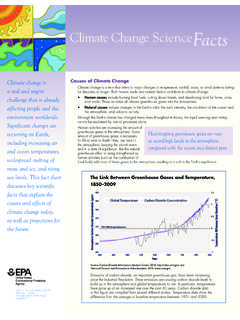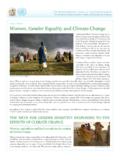Transcription of WEATHER AND CLIMATE - US EPA
1 WEATHER AND CLIMATE : WHAT S THE DIFFERENCE? 1 TIME: Introduction: 30 minutes Data collection: 10 minutes per day (for one or more weeks) Part 1 graphing/analysis: 45 minutes Part 2 graphing/analysis: 45 minutes Part 3 discussion: 15 minutes LEARNING OBJECTIVES: Students will: Learn to collect and graph local WEATHER data Learn to access and understand longer-term local CLIMATE data Understand the general distinctions between WEATHER and CLIMATE Understand that daily WEATHER measurements are highly variable compared with longer-term CLIMATE data NATIONAL SCIENCE STANDARDS: Content Standard A: Science as inquiry Content Standard D: Earth and space science ADAPTED FROM.
2 National Center for Atmospheric Research (NCAR)/University Corporation for Atmospheric Research (UCAR): DESCRIPTION This lesson plan enables students to learn the differences between WEATHER and CLIMATE . Students collect local WEATHER data for a defined period of time, and then compare these data with longer-term CLIMATE data for their community. BACKGROUND WEATHER is a specific event or condition that happens over a period of hours or days. For example, a thunderstorm, a snowstorm, and today s temperature all describe the WEATHER . WEATHER is highly variable day to day, and from one year to the next. For example, Minneapolis might have a warm winter one year and a much colder winter the next.
3 This kind of change is normal. But when the average pattern over many years changes, it could be a sign of CLIMATE change. CLIMATE refers to the average WEATHER conditions in a place over many years (usually at least 30 years, to account for the range of natural variations from one year to the next). For example, the CLIMATE in Minneapolis is cold and snowy in the winter, while Miami s CLIMATE is hot and humid. The CLIMATE in one area, like the Midwest or Hawaii, is called a regional CLIMATE . The average CLIMATE around the world is called global CLIMATE . When scientists talk about global CLIMATE change, they re talking a pattern of changes happening around the world over many years.
4 One of the most important trends that scientists look at is the average temperature of the Earth, which has been increasing for many years. Rising global temperatures are leading to other changes around the world, such as stronger hurricanes, melting glaciers, and the loss of wildlife habitats. That's because the Earth s air, water, and land are all related to one another and to the CLIMATE . By examining trends in WEATHER and temperature data, along with the changes occurring in all of these systems, scientists can get a good understanding of today s CLIMATE change. MATERIALS Thermometer for recording temperature outdoors A copy of the Daily WEATHER Data worksheet for each day of data collection A copy of the Instructions for Getting CLIMATE Data (Daily Average Temperature) for each student or group of students (optional: the educator can look up these data ahead of time and fill in the table before the class to save time) WEATHER AND CLIMATE : WHAT S THE DIFFERENCE?
5 2 A copy of the Instructions for Taking WEATHER Observations for each student group, plus one additional copy to post in the classroom A copy of WEATHER vs. CLIMATE Summary for each student or group A copy of the Temperatures in the Contiguous 48 States, 1901 to 2011 graph Graph paper for each student Pencils Colored pencils Computer and Internet access WEATHER vs. CLIMATE It is normal for the WEATHER to change on a daily or even hourly basis. But when the average pattern over many years changes, it is a sign of CLIMATE change. Image source: WEATHER AND CLIMATE : WHAT S THE DIFFERENCE? 3 VOCABULARY CLIMATE : The average WEATHER conditions in a particular location or region at a particular time of the year.
6 CLIMATE is usually measured over a period of 30 years or more. CLIMATE change: A significant change in the Earth s CLIMATE . The Earth is currently getting warmer because people are adding heat-trapping greenhouse gases to the atmosphere. The term global warming refers to warmer temperatures, while CLIMATE change refers to the broader set of changes that go along with warmer temperatures, including changes in WEATHER patterns, the oceans, ice and snow, and ecosystems around the world. Global warming: An increase in temperature near the surface of the Earth. Global warming has occurred in the distant past as the result of natural causes. However, the term is most often used to refer to recent and ongoing warming caused by people s activities.
7 Global warming leads to a bigger set of changes referred to as global CLIMATE change. WEATHER : The condition of the atmosphere at a particular place and time. Some familiar characteristics of the WEATHER include wind, temperature, humidity, atmospheric pressure, cloudiness, and precipitation. WEATHER can change from hour to hour, day to day, and season to season. WEATHER AND CLIMATE : WHAT S THE DIFFERENCE? 4 INSTRUCTIONS Advance Preparations 1. Familiarize yourself with the procedure for using your thermometer to collect atmospheric temperature data by referring to the steps in Procedure for Measuring Daily Temperature. 2. Determine how long you want students to collect WEATHER data (for example, a week, a month, or several months) for Part 1 of this lesson.
8 Depending on your location, one week to two weeks of data collection might be enough to illustrate WEATHER variation. 3. For Part 2 of the lesson, familiarize yourself with the longer-term CLIMATE data at and prepare the worksheets by following the steps in "Instructions for Getting CLIMATE Data (Daily Average Temperature). Part 1: Collecting Temperature Data 1. Explain to students that they will collect temperature data to see how the temperature varies from day to day. 2. Ask students to brainstorm what other aspects or characteristics of the WEATHER might influence temperature). [Answer: wind, precipitation, cloudiness.] Tell students that they will collect data about these factors too.
9 3. Hand out a copy of the Daily WEATHER Data worksheet to each student. Have students break into pairs. Tell students that each day a different pair of students will take WEATHER measurements and record these measurements in this worksheet. 4. Introduce students to the procedure for taking the thermometer out of doors. Pass out the Procedure for Measuring Daily Temperature handout to each pair of students and guide them through the steps of using the thermometer. Post the procedure in a prominent classroom location for future reference. 5. Tell students that because different people will be collecting data, it is important to collect the data the same way each time to be consistent.
10 Explain that every observation should be made at a consistent time of the day and the same location. Ask students what time of day they would expect the temperature to be the highest, and what time they would expect to observe the lowest temperature. [Answer: The warmest part of the day is usually in the afternoon. Although the sun is at its highest in the sky at noon, it takes time for land and water to heat up, which is why the hottest part of the day typically occurs later in the afternoon. The temperature generally falls as the sun goes down in the evening and at night, and gradually increases again as the sun rises in the morning.] As a group, determine a time and location to take measurements every day.

















